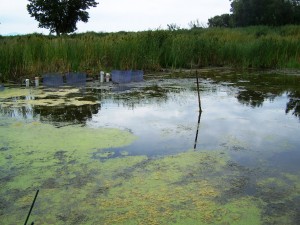Day 3,
Its been a number of months since I visited. With the data all collected and the majority of the sensors in we had neither time, nor funding, nor reason to visit Hobble Creek. We were content to let the snows of winter come in and cover the ponds. I had stopped in briefly in February to service our last remaining oxygen sensor. We quickly became engrossed in other pursuits; a study abroad on the coast, a tide pool research project, a new biology building, and a few weeks of camping here and there.
In the process of moving I remember that oxygen sensor. The manufacturers suggested visiting it at least monthly to make sure no biofilm or algae covered the sensor. I had to go back. A quick visit. No measurements or cameras, just me and some waders on a cool summer morning after a wild thunderstorm. And then I remembered them.
When I first started working in Hobble Creek I noticed that the mosquito bites affected me quite differently than the bites I routinely collected on visits to the Uinta Mountains. Those bites tended to be small, numerous, and forgettable within a few hours. At Hobble Creek the bites resembled golf balls which reduced to bruises after a few days. The mosquitoes had a brown-red look to them suggestive of the genus Anopheles, notable for its ability to transmit malaria. With the reduction in our field research this spring the mosquitoes would be missing an important part of their diet. They would be starving.
A female Anopheles requires a blood meal to oviposit. They can lay up to 200 eggs on a single blood meal with 100 eggs being more likely. In examining previous notes I estimated my personal research impact from the previous year to have resulted in the premature destruction of 468 females, give or take.
Okay, if I fed 5 individuals I could removed my influence on the population. I could do that. I traded my sandals for waders and set out into the wetland. I moved cautiously at first but didn’t notice any activity. Maybe I had reached a rare lull in the mosquito presence which sometimes happens in afternoon heat or late August. I was soon caught up in the beauty of the area, the surviving Populous fremontii had grown significantly in the 3 years of my work there. The water levels were unusually high for that time of summer perhaps due to the heavy rains the night before. My pond, #6, was fuller than it had been at any time during the last summer when we spent days measuring oxygen concentrations. I plunged in and marveled at the thick layer of Chara coating the ooze. Chara is the notoriously smelly plant that caused a minor evacuation in the biology building last year when I tried to dry it out. I wonder if the decomposing Chara in the mud was in some way responsible for the thick odors arising from gas bubbles released by my boots.
That’s when they found me. I felt my right arms hairs stir and looked to see three females with piercing mouth parts already accepting my donation. I gritted my teeth and resisted the urge to run. I reached the sensor and found it in good shape, I cleaned off the important parts and checked the depth to make sure it wasn’t embedded in sediment. Looked good. I swatted a bunch on my neck. Time to go. Several were on my left arm now and I allowed a swift sweep my glove to remove them. I charged out of the pond and found the Chara even thicker than I had observed. The bites came faster now as I headed for the car. Then I remembered the smell, I had to rinse the waders first. I changed course and headed for the main creek. I was swinging the glove like a horse-tail to keep the Culicidae airborne as I charged into the creek below the old beaver dam. Deeper than expected. Also rather sediment filled so I couldn’t see my foot placement. I coated my arms in duckweed as an added protection and continued. I would smell like hydrogen sulfide for a few days regardless of how many showers I took but I had to make choices.
I arrived at the car and peeled off the waders and huddle in the seat trying to get my sandals back on. None appeared to have made it to the car. I took stock.
Two on the left arm, three on the right, one on the right hand and…two? on the neck. I think I had crushed at least two of the successful girls that meant I had provided the blood meal for 6 expecting mothers.
Another 600 mosquitoes. Oops.
Maintaining ecosystems is hard. It requires sacrifice. Sacrifice for organisms most people would rather see eradicated. Organisms that government agencies actively search and destroy.
Sometimes being an ecologist is a thankless job.


Riley I miss your sense of humor!
Chortle chortle. You are so weird. I really enjoyed reading this.